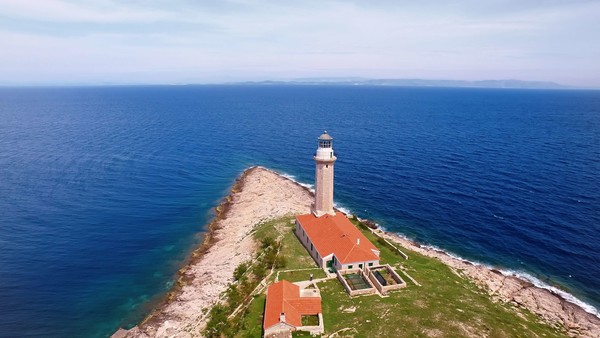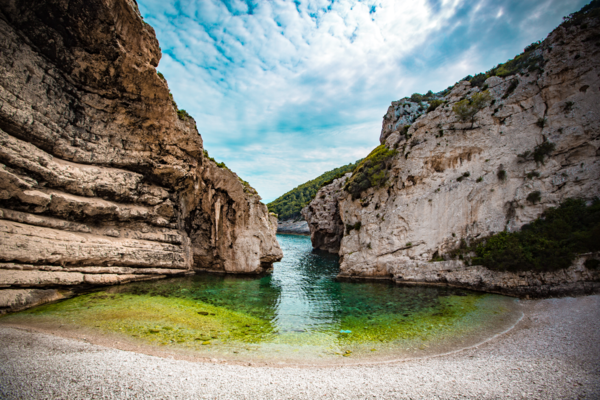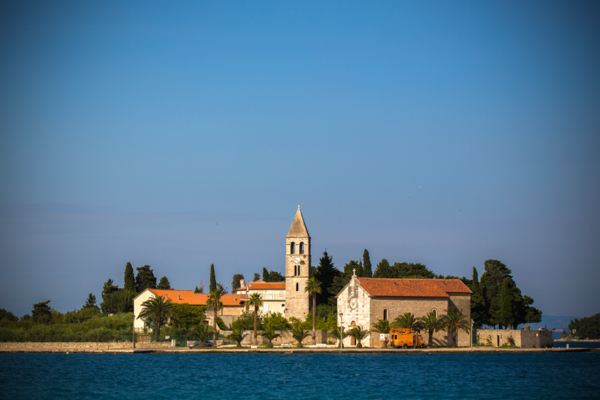The Island of Vis

[아츠앤컬쳐] 비스 섬은 크로아티아 본토에서 가장 멀리 떨어진 유인도(有人島)로 약 90 km²의 면적과 해발 587미터의 험 산(Mount Hum) 및 약 4,000명의 인구가 살고, 스플리트-달마티아 주에 속한다. 2003년, 세계자연기금(WWF)은 고유한 자연, 문화 유적, 해로(海路)의 교차점이자 도시 문명의 기원이었던 군도의 역사로 인해 이곳을 “지중해 낙원 오아시스” 열 곳 중 하나로 선정했고, 천연기념물을 많이 보유하고 있어, 유네스코세계지질공원 네트워크에 속해 있다.
비스는 지중해에서 아름다운 자연 명소가 많이 있는 섬이다. 2016년, 유럽에서 가장 아름다운 해변으로 선정된 스티니바 해변은 우뚝 솟은 절벽 뒤에 숨겨져 아름다운 자갈 해변으로 이어지는 좁은 만을 통해서만 들어갈 수 있다. 근처의 비셰보섬은 한낮에 동굴 천장의 개구부에서 들어오는 태양빛이 안쪽까지 비쳐 경이로운 영롱한 푸른 동굴로 변모시킨다. 방문객들은 푸른 동굴 속에서 마법 같은 수영을 경험할 수도 있다.

비스의 역사는 원시시대까지 거슬러 올라가며, 이는 섬의 테우타동굴에서 발굴된 구석기시대의 도자기로 입증된다. 기원전 4세기 초, 고대의 이사(Issa)로 알려진, 자체 통화가 있던 독자적 도시국가가 비스 마을에 있었고, 이 지역에서 가장 중요한 그리스 식민지가 되었다. 비스는 기원전 46년에는 로마인들에게, 서기 10세기에는 베네치아에 지배를 받았으며, 르네상스와 바로크 시대에 경제 및 문화적 번영기를 누리기도 했다.
비스는 풍부한 역사를 지닌 가운데 여러 국가와 제국의 지배를 받았다. 또한, 제2차 세계대전 중 역사, 군사 및 전략적으로 매우 중요한 역할을 했다. 이 섬은 영국 황실 공군의 공항 기지였고, 게릴라와 연합군에게도 매우 중요했다. 규모가 큰 지하 터널과 요새가 있는 비스의 군사적 용도는 냉전시기에도 빛을 발했다. 크로아티아 독립 이후 이 섬을 찾은 외국 관광객들은 잠수함 기지와 군사 터널을 포함해 방어 시설들을 탐험하며 비스의 흥미로운 과거를 엿볼 수 있었다.
본 섬의 가장 큰 두 마을인 비스와 코미자의 건축물들은 로마 시대부터 근대까지의 영향을 받아온 역사를 보여준다. 비스는 로마 시대의 유적, 르네상스의 뜰 및 영국 군사 시설의 컬렉션으로 유명하다. 반면에, 코미자는 좁은 조약돌 거리, 어부의 집, 항구를 향한 오래된 요새 등이 유명하다. 비스 섬은 본 섬의 그림 같은 광경을 보여주었던 영화 ‘맘마미아’의 촬영지로도 유명하다. 맘마미아 팬들은 맘마미아의 주요 장면들이 촬영되었던 아름다운 장소들을 보기 위해 이 섬을 자주 찾는다.
비스는 고독과 자연의 아름다움, 그리고 역사적인 면에서 아드리아해의 독보적인 관광지다. 유적지 탐험, 멋진 해변, 항해, 스쿠버 다이빙, 또는 그저 여유로운 라이프스타일로 혼잡한 관광지로부터 벗어나고자 하는 여행객들에게 이상적인 행선지가 될 것이다.

The Island of Vis
The Island of Vis is the furthest inhabited island from the Croatian mainland, part of Split-Dalmatia County, with a surface area of about 90 km², peaks at 587 meters above sea level at Mount Hum, and a population of around 4,000 inhabitants.
In 2003, the WWF declared the Vis archipelago, one of the last ten “paradise oases of the Mediterranean”, due to its distinctive natural features, cultural heritage, history of the island as an intersection of maritime routes and as the origin of urban civilization. This open sea island is also the area with the largest concentration of nature monuments in Croatia, and UNESCO’s World Network of Geoparks proclaims the Vis Archipelago – a Geopark.

Vis is home to some of the most stunning natural attractions in the Mediterranean. Stiniva Beach, hidden behind towering cliffs, was voted the most beautiful beach in Europe in 2016. It is accessible only by a narrow cove that opens up to a beautiful pebble beach. The nearby Biševo Island features the mesmerizing Blue Cave, where natural light transforms the interior into a luminous blue wonder in the middle of the day. Another natural marvel, the Green Cave, is famous for its shimmering green light caused by the sun shining through an opening in the roof, offering visitors a magical swimming experience.
The history of Vis stretches back to prehistoric times, evidenced by Eneolithic pottery excavated in the island’s Teuta cave. At the beginning of the 4th century BC, an independent city-state known as ancient Issa, complete with its own currency, emerged in what is now Vis town, becoming the region's most significant Greek colony. After falling to the Romans in 46 BC, Vis came under Venetian control in the 10th century AD. The island also enjoyed periods of economic and cultural prosperity during the Renaissance and Baroque eras.
Throughout its rich history, Vis has been governed by different nations and empires. However, during WWII, the island played a historically, militarily, and strategically significant role. It was notably important for the Partisans and Allied Forces, serving also as a base with a British Royal Air Force airport. The military significance of Vis extended into the Cold War, marked by extensive underground tunnels and fortresses. When the island opened to foreign tourists after Croatia gained its independence, visitors could explore these fortifications, including a submarine base and military tunnels, providing a glimpse into the island's intriguing past.
The architecture of Vis reflects its layered history, with influences from Roman times to the modern era. Vis and Komiža, the island's two largest towns, are rich in historical architecture. Vis boasts a collection of Roman ruins, Renaissance courtyards, and British military installations. In contrast, Komiža is characterized by its Mediterranean charm, with narrow cobblestone streets, fishermen’s houses, and a historic fortress overlooking the harbor.

The island gained additional fame as a filming location for "Mamma Mia! Here We Go Again," showcasing its picturesque scenery to audiences worldwide. Fans of the film often visit to see the scenic sites where key scenes were shot, blending cinematic history with real-life beauty.
Vis offers a compelling mix of solitude, natural beauty, and history, making it an exceptional destination within the Adriatic. Whether it's exploring historic sites, enjoying stunning beaches, sailing, scuba diving, or simply soaking in the laid-back lifestyle, Vis has become the ideal destination for tourists looking to escape the more crowded tourist spots of the Mediterranean.

글 Loreta Bertosa-Kusen
Minister Plenipotentiary
Embassy of Croatia, London

